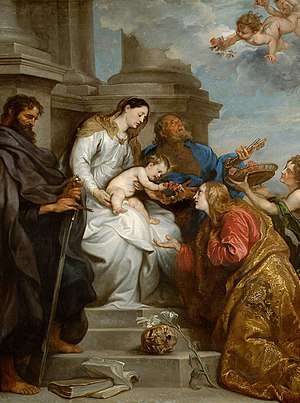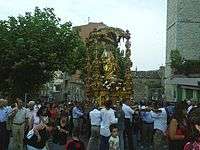Saint Rosalia
Saint Rosalia (1130–1166), also called La Santuzza or "The Little Saint", and in Sicilian as "Rusulia", is the patron saint of Palermo in Italy, Camargo, Chihuahua, and three towns in Venezuela: El Hatillo, Zuata, and Anzoátegui. She is especially important internationally as a saint invoked in times of plague (disease). In 2020, she is being invoked by the citizens of Palermo to protect the city from COVID-19.[2]
Saint Rosalia | |
|---|---|
 The Coronation of Saint Rosalia by Anthony van Dyck | |
| Virgin | |
| Born | 1130 Palermo, Kingdom of Sicily |
| Died | 1166 (aged 35–36) Mount Pellegrino, Kingdom of Sicily |
| Venerated in | Roman Catholic Church |
| Feast | 14 July (Festino), 4 September (Pilgrimage on Monte Pellegrino) |
| Attributes | Depicted as a young woman, sometimes holding a cross, book, or skull, and also a spray of lilies.[1] Some images show her holding a chisel and hammer with which she carved her dedication (see main story). She is also seen wearing a crown of roses, attended by winged angels, and often with a view through a cave opening of Palermo Harbour. |
| Patronage | Palermo; El Hatillo; Zuata Anzoátegui; and El Alto de Escuque Trujillo Italian fishermen of Monterey, California |
Biography
.jpg)
Rosalia was born of a Norman noble family that claimed descent from Charlemagne. Devoutly religious, she retired to live as a hermit in a cave on Mount Pellegrino, where she died alone in 1166. Tradition says that she was led to the cave by two angels. On the cave wall she wrote "I, Rosalia, daughter of Sinibald, Lord of Roses, and Quisquina, have taken the resolution to live in this cave for the love of my Lord, Jesus Christ."[3]
1624 plague
In 1624, a plague beset Palermo. During this hardship Saint Rosalia appeared first to a sick woman, then to a hunter, to whom she indicated where her remains were to be found. She ordered him to bring her bones to Palermo and have them carried in procession through the city.[4]
The hunter climbed the mountain and found her bones in the cave as described. He did what she had asked in the apparition. After her remains were carried around the city three times, the plague ceased. After this Saint Rosalia was venerated as the patron saint of Palermo, and a sanctuary was built in the cave where her remains were discovered.[5]
Her post-1624 iconography is dominated by the work of the Flemish painter Anthony van Dyck, who was trapped in the city during the 1624–1625 quarantine, during which time he produced five paintings of the saint, now in Madrid, Houston, London, New York and Palermo itself. In 1629 he also produced Saint Rosalia Interceding for the City of Palermo and Coronation of Saint Rosalia to assist Jesuit efforts to spread her cult beyond Sicily.
Veneration
The feast of Saint Rosalia is on 4 September.[3]
In Palermo, the Festino di Santa Rosalia is held each year on 14 July, and continues into the next day.[6] It is a major social and religious event in the city. In 1995, 1996, 1997[7] and 2001 the celebration was produced by Studio Festi.
On 4 September, a tradition of walking barefoot from Palermo up to Mount Pellegrino is observed in honor of Saint Rosalia.[8] In Italian-American communities in the United States, the July feast is generally dedicated to Our Lady of Mount Carmel[9] while the September feast, beginning in August, brings large numbers of visitors annually to the Bensonhurst section of Brooklyn in New York City.[10]
In biology
Saint Rosalia was proposed as the patron saint of evolutionary studies in a paper by G.E. Hutchinson.[11] This was due to a visit he paid to a pool of water downstream from the cave where St. Rosalia's remains were found, where he developed ideas based on observations of water boatman.[12]
In art
Saint Rosalia was an important subject in Italian Renaissance and Baroque painting, particularly in sacre conversazioni (group pictures of saints flanking the Virgin Mary) by artists such as Riccardo Quartararo, Mario di Laurito, Vincenzo La Barbara, and possibly Antonello da Messina.[13] But it was Flemish master Anthony Van Dyck (1599–1637), who was caught in Palermo during the 1624 plague, who produced the most paintings of her (see also above). His depictions – a young woman with flowing blonde hair, wearing a Franciscan cowl and reaching down toward the city of Palermo in its peril – became the standard iconography of the saint from that time onward. Van Dyck's series of St. Rosalia paintings have been studied by Gauvin Alexander Bailey and Xavier F. Salomon, both of whom curated or co-curated exhibitions devoted to the theme of Italian art and the plague.[14][15][16] In March 2020, The New York Times published an article about the Metropolitan Museum of Art's painting of Saint Rosalia by Van Dyck in the context of Covid-19.[17]
References
- Stracke, Richard (20 October 2015). "Rosalia of Palermo". Christian Iconography.
- Tondo, Lorenzo (13 March 2020). "Palermo pins hopes on patron saint to rid Italy of coronavirus" – via www.theguardian.com.
- "St. Rosalia". Catholic Online. Retrieved 12 July 2018.
- "Santa Rosalia". Italian Folk Magic. 4 September 2017. Retrieved 14 July 2018.
- For the great expansion of Rosalia's popular cult in Italy as a result of the 1624 plague, see Franco Mormando, "Response to the Plague in Early Modern Italy: What the Primary Sources, Printed and Painted, Reveal" in Hope and Healing: Painting in Italy in a Time of Plague, 1500–1800, ed. G. Bailey, P. Jones, F. Mormando, and T. Worcester, Worcester, Massachusetts: The Worcester Art Museum,2005, pp. 32–34.
- Bommarito, Maria Lina (13 July 2014). "The "Festino" of Santa Rosalia in Palermo". Times of Sicily. Retrieved 16 July 2017.
- "YouTube". www.youtube.com.
- Bommarito, Maria Lina (3 September 2014). "The Mount Pellegrino Climb in Honor of Santa Rosalia". Times of Sicily. Retrieved 12 July 2018.
- Vaudoise, Mallorie (4 September 2017). "Santa Rosalia". ItalianFolkMagic.com. Retrieved 22 May 2019.
- Sperling, Jonathan (9 August 2017). "Bensonhurst gears up for 42nd Annual Feast of Santa Rosalia". Brooklyn Reporter. Retrieved 12 July 2018.
- Hutchinson, G. E. (1 May 1959). "Homage to Santa Rosalia or Why Are There So Many Kinds of Animals?". The American Naturalist. 93 (870): 145–159. doi:10.1086/282070. ISSN 0003-0147. JSTOR 2458768.
- Hutchinson, G.E. (May–June 1959). "Homage to Santa Rosalia or Why Are There So Many Kinds of Animals?". The American Naturalist. 93 (870): 145–149. doi:10.1086/282070. JSTOR 2458768.
- Gauvin Alexander Bailey, "Anthony van Dyck, the Cult of Saint Rosalie, and the 1624 Plague in Palermo," in Gauvin Alexander Bailey et al., Hope and Healing: Painting in Italy in a Time of Plague (Worcester and Chicago, 2005): 118–36.
- Cotter, Holland (29 July 2005). "Desperately Painting the Plague" – via NYTimes.com.
- Bailey, Gauvin Alexander (1 March 2012). "Van Dyck in Sicily: while the plague held Palermo in its grip, Anthony van Dyck radically developed 12th-century iconography of Saint Rosalie through five paintings that imbued the saint with a sensual refinement. Van Dyck's Rosalie became one of Catholicism's most popular images of victory over pestilence, and represents a key period in the artist's development". Apollo. 175 (596): 116–122 – via go.gale.com.
- "2012: Van Dyck in Sicily | Dulwich Picture Gallery". www.dulwichpicturegallery.org.uk.
- Farago, Jason (26 March 2020). "The Saint Who Stopped an Epidemic Is on Lockdown at the Met" – via NYTimes.com.
External links
| Wikimedia Commons has media related to Saint Rosalia. |

